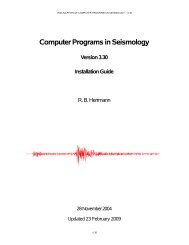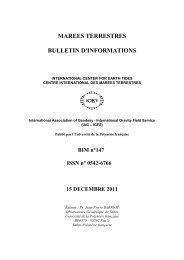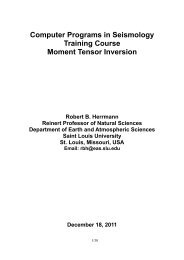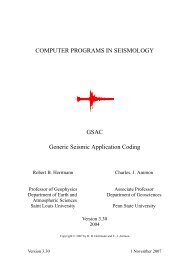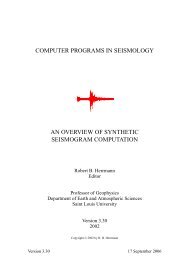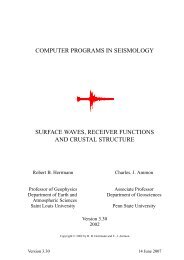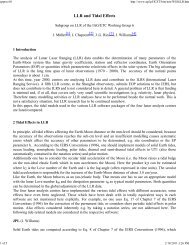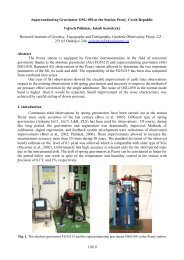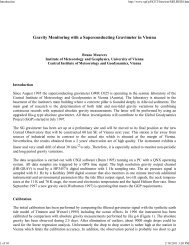3.04 Gravimetric Methods – Superconducting Gravity Meters
3.04 Gravimetric Methods – Superconducting Gravity Meters
3.04 Gravimetric Methods – Superconducting Gravity Meters
You also want an ePaper? Increase the reach of your titles
YUMPU automatically turns print PDFs into web optimized ePapers that Google loves.
88 <strong>Superconducting</strong> <strong>Gravity</strong> <strong>Meters</strong><br />
Ocean loading corrections are frequently geared<br />
to the need for precise geodetic information in particular<br />
areas such as Antarctica (Bos et al., 2000) or the<br />
Pacific Northwest (Lambert et al., 2003).<br />
<strong>3.04</strong>.2.2.4 Tidal analysis<br />
Tidal analysis consists of determining the amplitudes<br />
and phases of tidal waves of specific frequencies from<br />
observational data. How many waves can be determined<br />
and to what accuracy depends on the length of<br />
the record used and on the noise characteristics of the<br />
site. In most approaches, the ocean tides are grouped<br />
in with the solid tides of the same frequency, and<br />
they cannot be separated by a simple fit of data to<br />
known tidal frequencies. Ocean tide variability is<br />
reflected in the time dependence of the gravimetric<br />
tidal factors at a particular site.<br />
Three programs are used within the SG community<br />
for tidal analysis. The most widespread program<br />
is ETERNA, developed over many years by Wenzel<br />
(1996b) and now in its final form (version 3.3). It<br />
consists of a suite of several programs that deal with<br />
all the common aspects of processing gravimeter data<br />
and it can be adapted to a variety of different data<br />
sets; it can also be used for analysis of strain and tilt<br />
data as well as gravity. ETERNA is a harmonic<br />
method that does a direct least-squares fitting of the<br />
(, ) factors for various wave groups to gravity data<br />
sampled at fixed intervals, for example, 1 min or 1 h.<br />
The program can handle different sub-blocks of data<br />
if there are gaps. The user has the choice of simultaneously<br />
fitting an admittance function to pressure or<br />
other auxiliary data. It includes polar motion and<br />
different assumptions regarding the instrument drift<br />
function. The program is well documented and available<br />
through ICET.<br />
The second approach is a program called<br />
BAYTAP-G that was developed by Japanese geophysicists<br />
during the 1980s (Tamura et al., 1991).<br />
The approach is a hybrid method using a combination<br />
of harmonic series and the response method<br />
(Lambert, 1974) to estimate the various components<br />
of a gravity record (i.e., the tidal parameters, a pressure<br />
perturbation effect, a ‘drift’ function, and<br />
irregular noise). One of the distinguishing aspects of<br />
the program is a focus on a statistical description of<br />
the ‘drift’, which in this context means the entire<br />
long-term gravity signal and not just the instrument<br />
drift, and of the random noise Using Bayesian estimates,<br />
the procedure involves the nonlinear<br />
estimation of a tradeoff parameter between the tidal<br />
harmonic series and the residual gravity.<br />
A third program is available, called VAV, which<br />
was described most recently by Venedikov and Viera<br />
(2004). The origins of this approach go back 50 years<br />
or more when gravimeter records were processed by<br />
the application of suitable filters of various lengths to<br />
account for the tides. Comparisons exist between<br />
VAV and ETERNA but the former has not been as<br />
widely adopted by the SG community as the other<br />
programs. Dierks and Neumeyer (2002) compared all<br />
three programs using both synthetic data and a 1 year<br />
observed SG data set from station Sutherland (SA).<br />
They found the performance of the three programs<br />
to be similar, but with different treatments of the<br />
statistics between signals (tides, pressure, and drift)<br />
and residual gravity. The spectra of the final residuals<br />
were noticeably different between the programs, and<br />
the reader should consult their paper for details (also<br />
for valuable tips on how to set some of the parameters<br />
in the program inputs).<br />
A few words should be said about the response<br />
method in SG tidal analysis, as discussed by Merriam<br />
(2000). Rather than allocating for all waves within a<br />
group the same gravimetric factor, the response<br />
method selectively interpolates the gravimetric factors<br />
using only waves that seem unperturbed by noise<br />
(i.e., that are close to their theoretical expectations).<br />
Waves that seem anomalous are thus treated independently,<br />
requiring a more hands-on treatment, but<br />
one that has some practical advantages. The additional<br />
flexibility allows a greater reduction in tidal<br />
residuals, because it can accommodate the more variable<br />
ocean loading.<br />
<strong>3.04</strong>.2.3 Atmospheric Pressure Effects<br />
The atmosphere provides a significant gravity effect<br />
(up to 10% of the tidal signal) with a transfer function<br />
(or admittance factor) that approximates <strong>–</strong>0.3 mGal<br />
hPa 1 for a typical continental station. The effect is a<br />
combination of gravitational attraction by atmospheric<br />
density anomalies with a loading that<br />
vertically deforms the crust and mantle. For a positive<br />
atmospheric density anomaly, simple theory<br />
gives about <strong>–</strong>0.4 mGal hPa 1 for the upward attraction<br />
and þ0.1 mGal hPa 1 for the loading. A number<br />
of well-studied empirical and physical methods exist<br />
for making a pressure correction to the gravity data,<br />
but even with the most sophisticated treatments it is<br />
not possible to completely remove the atmospheric<br />
pressure effect.




